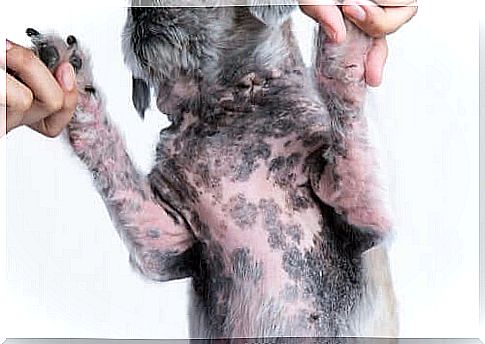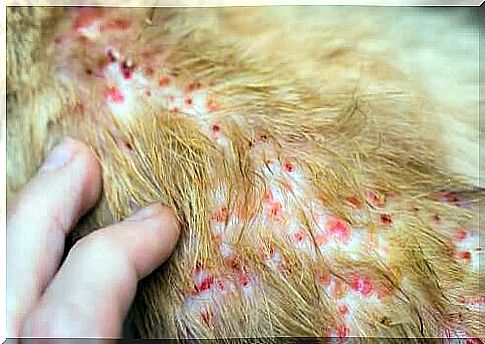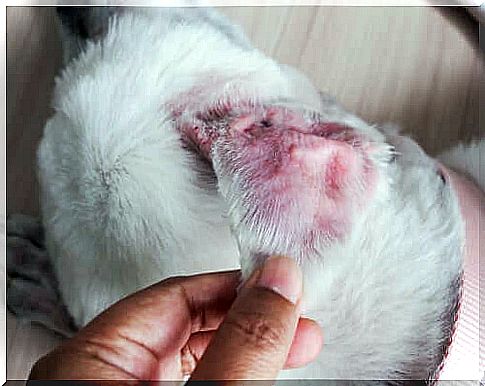How To Cure Allergic Dermatitis In Dogs

Allergic dermatitis in dogs or topical canine dermatitis is an inflammatory disease that causes noticeable itching. It is associated with genetic factors. About 10% of dogs suffer from it today, and the number is increasing. The same happens in the case of human beings.
It has been shown that, to a large extent, allergic dermatitis in dogs is associated with an increase in immunoglobulin E (IgE), which results from contact with environmental allergens of different nature. Nonetheless, there are additional immune factors that may be associated with the phenomenon.
In addition, this kind of dermatitis is characterized by the appearance of a large number of secondary pains. For this reason, there are several treatments for allergic dermatitis in dogs.
Treatment for infections
One of the problems posed by allergic dermatitis in dogs is secondary infections that appear on damaged skin. On the skin resides a bacterial flora necessary for the maintenance of the general health of the organism.
When the tissue is damaged, there is a proliferation of some harmful microorganisms that can cause severe skin infections. Among them are staphylococci and a fungus called Malassezia .
This type of infection is treated with broad-spectrum antibiotics, administered orally or topically. In addition, the application of antifungal treatments is necessary to combat fungi.
Treatment of allergic dermatitis in dogs due to flea bites
Many dogs suffering from atopic dermatitis have a greater predisposition to suffer from allergic dermatitis due to flea bites. Faced with these cases, the first measure to be taken is to completely eliminate the parasite.
In addition, it will be necessary to use a good repellent to prevent the animal from returning to present a new episode. We will thus be able to protect it from relapses.

Power management
On many occasions, the allergen can consist of a food or an ingredient found in the dog’s food. In this case, we must adopt an elimination diet: in this way we can determine what the dog is allergic to.
On the other hand, there are hypoallergenic feeds that, in these situations, can be useful. However, in most cases, these allergies derive from the consumption of highly processed foods, such as feeds, which, moreover, may contain ingredients that do not need to be specified.
For this reason, the best choice is an elimination diet consisting of the use of 100% natural products. Avoiding allergenic foods is crucial.
Treatment of kerato-seborrhea
Kerato-seborrhea is a process of keratinization and subsequent peeling of the skin, accompanied by an excess of sebaceous secretion and caused by an obstruction of the sebaceous glands. This is a common symptom in allergic dermatitis in dogs, especially in chronic patients.
In these cases, treatment is based on the use of oral fatty acid supplements. In addition, specific shampoos can be used.
Treatment of external otitis
External otitis is one of the most important secondary diseases that can arise in case of allergic dermatitis in dogs. Generally, it occurs in the form of inflammation of the external auditory canal and the pinna.
In addition, bacterial and fungal infections appear. There may also be an excess of secretions that make otitis chronic.

Specific treatments for allergic dermatitis in dogs
In the first place, the ideal is to avoid that the dog comes into contact with any substance that could cause him an allergy. For this purpose, an intradermal test must be performed, thanks to which it is possible to check which substances the dog’s skin reacts to.
Usually, dogs are allergic to house mites; consequently, it is recommended to carry out the cleaning of the house using anti-mite vacuum cleaners, in addition to avoiding keeping fabrics capable of attracting these animals.
On the other hand, there is also specific immunotherapy. It is applied using drugs that intervene in the body’s immune response and control, among various organisms, T lymphocytes and E immunoglobulins.
Use of glucocorticoids in the treatment of allergic dermatitis in dogs
Corticosteroids are particularly effective drugs to eliminate the annoying symptoms of canine atopic dermatitis. Nonetheless, they do not cure the disease, but merely conceal it.
In this way, the dog will not suffer from itching and swelling of the skin and thus the appearance of secondary diseases will be avoided. However, these drugs cannot be used indefinitely, but alternative therapies need to be sought.









